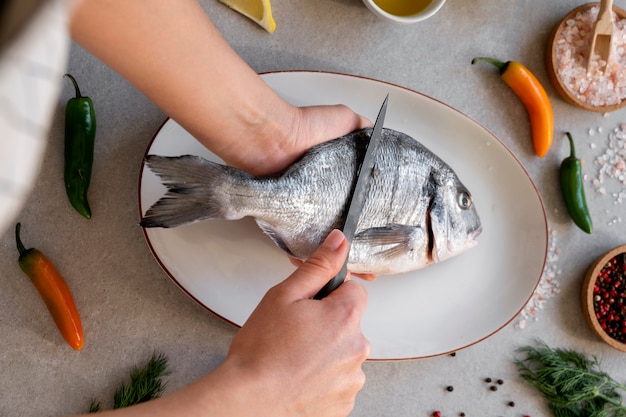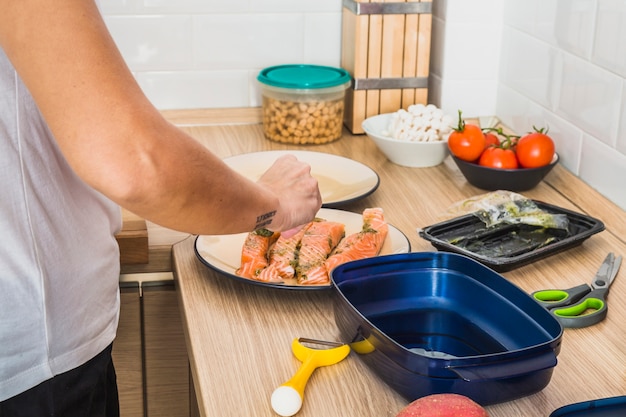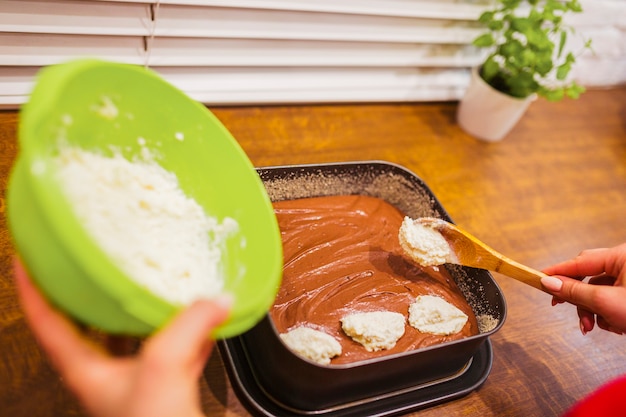I've always been a fan of tilapia. It's a versatile, lean fish that’s easy to cook and a blank canvas for flavour experimentation. Baking it is my go-to method – it’s so simple, and you can get really creative with your seasonings and toppings. However, I've learned through trial and error that getting the bake time right is crucial. I’ve had my share of dry, overcooked tilapia, which, let's be honest, is a culinary crime. But I've finally cracked the code, and I’m excited to share my secrets to achieving tilapia perfection!
(Part 1) The Science Behind Baking Tilapia: A Delicate Dance

Before we delve into the specifics of baking time, let's talk about the science behind it. Think of tilapia as a delicate ballerina. It’s got a thin flesh, and it cooks quickly – you want to make sure it stays moist and tender, like a graceful pirouette. One wrong move, and it can become dry and rubbery, like a clumsy stumble.
The Temperature Tango
The ideal temperature for baking tilapia is 400 degrees Fahrenheit (200 degrees Celsius). This high temperature helps to ensure that the fish cooks through quickly and evenly. It’s like a hot stage light, bringing the fish to life without scorching it. I’m talking about the oven temperature, not the temperature of the fish itself. We'll discuss checking the internal temperature of the fish later on.
The Size Factor
The size of the tilapia fillet plays a big role. A thinner fillet, like a petite dancer, will cook faster than a thicker one. I’ve found that most tilapia fillets take between 10 to 15 minutes to bake, but it’s always best to err on the side of caution. It's much easier to cook a fish for a few extra minutes than it is to try to salvage an overcooked one!
(Part 2) Getting Ready for the Bake: The Culinary Choreography

Now that we understand the science behind baking tilapia, let's get into the practical steps of preparing those fillets for the oven. It’s all about preparation, and it starts with the right tools.
Essential Tools: The Stage Props
- Baking sheet: This is the stage for your tilapia performance. Make sure it's large enough to hold all the fillets without overcrowding. You want them to have enough room to breathe, like dancers in a spacious studio.
- Parchment paper: This is my go-to for baking tilapia. It helps prevent sticking and makes cleanup a breeze. It's like a protective layer for your stage floor.
- Spatula: You'll need a spatula to transfer the tilapia fillets to the baking sheet and to check if they’re done. It's your backstage assistant, helping you move the fish and ensure it's ready for its curtain call.
- Oven thermometer: This is optional, but if you want to be extra sure about your oven temperature, an oven thermometer is a great investment. It's like a backstage monitor, ensuring the stage lights are at the right intensity.
Prepping the Tilapia: The Rehearsal
Before you even think about putting those tilapia fillets in the oven, they need a bit of TLC. It's not complicated, but it makes all the difference.
- Rinse and pat dry: Start by giving the fillets a good rinse under cold water. This removes any excess debris or slime. Then, pat them dry with paper towels. This helps to prevent the fillets from steaming in the oven, which can make them soggy.
- Seasoning: Here's where you get to have fun. There are so many ways to season tilapia! You can go classic with salt and pepper, or you can get creative with herbs and spices like garlic powder, paprika, oregano, and lemon pepper. It's like choosing the perfect costume for your dance – you want something that complements the fish and enhances its flavour.
- Marinate (optional): If you have time, marinating the tilapia in advance will enhance the flavour. Try a simple marinade of lemon juice, olive oil, and herbs, or get creative with soy sauce, honey, or ginger. It’s like a backstage warm-up, allowing the flavours to penetrate the fish and create a more intense performance.
(Part 3) Baking the Tilapia: Center Stage

Now comes the fun part! This is where the magic happens.
Preheat the Oven: Setting the Stage
The first step is to preheat your oven to 400 degrees Fahrenheit (200 degrees Celsius). Make sure you give the oven ample time to heat up, as this is crucial for even cooking. It's like preparing the stage lighting – you want the temperature to be just right so that the fish cooks evenly and beautifully.
Prepare the Baking Sheet: Setting the Scene
While the oven is preheating, line your baking sheet with parchment paper. This will make it easy to transfer the fish to a plate after baking and will prevent sticking. It’s like creating a beautiful backdrop for your performance.
Place the Tilapia on the Baking Sheet: Taking Position
Arrange the tilapia fillets on the prepared baking sheet. Make sure they’re not touching each other. You want to allow for good airflow around the fish, so they cook evenly.
Bake the Tilapia: The Performance Begins
Slide the baking sheet into the preheated oven and bake the tilapia for 10-15 minutes. The bake time will vary depending on the thickness of the fillets. To check if the tilapia is done, you can insert a fork into the thickest part of the fish. The fish is cooked through when the flesh is opaque and flakes easily. You can also use a meat thermometer to ensure the internal temperature of the fish reaches 145 degrees Fahrenheit (63 degrees Celsius).
(Part 4) Signs of a Perfectly baked tilapia: The Curtain Call
You’ve baked your tilapia, but how do you know if you've achieved perfection? It's all about understanding those telltale signs.
Appearance: A Striking Performance
A perfectly cooked tilapia will have a golden-brown exterior and a flaky white flesh. The skin should be crisp and easy to remove. It's like a dancer in a stunning costume, ready to take center stage.
Texture: A Smooth and Graceful Move
The fish should be tender and flaky, not rubbery or dry. It should give a little when you press it gently. It's like a dancer’s fluid movements – delicate but firm.
Internal Temperature: The Final Check
If you're using a meat thermometer, the internal temperature of the fish should reach 145 degrees Fahrenheit (63 degrees Celsius). It's like ensuring the dancer’s pulse is steady and strong.
(Part 5) Tips for perfect tilapia Baking: The Backstage Secrets
Here are a few more tips to ensure you achieve tilapia perfection:
Don't Overcrowd the Baking Sheet: Plenty of Space to Breathe
Give your tilapia fillets plenty of space to breathe in the oven. If the fillets are too close together, they won't cook evenly. It's like giving the dancers enough room to move gracefully without bumping into each other.
Flip the Fish Halfway Through: A Change of Pace
For extra crispy skin, flip the fish halfway through the baking time. However, if you're concerned about overcooking the delicate flesh, you can skip this step. It’s like adding a bit of variation to the dance routine – a change of pace to keep the performance interesting.
Don't Overcook: Finding the Right Rhythm
Overcooked tilapia is dry, rubbery, and a bit of a culinary crime. It's a fine line between perfectly cooked and overcooked. It’s better to check early and often and err on the side of undercooking, as you can always bake it a little longer if needed.
(Part 6) Serving the Baked Tilapia: The Grand Finale
Now for the best part, the presentation and the enjoyment. Here’s how to finish off your perfect tilapia dish:
Serving Suggestions: A Supporting Cast
Baked tilapia is a versatile dish that can be served with a variety of sides. I love to pair it with roasted vegetables, a simple salad, or a bed of rice. It's like choosing the right supporting actors for a successful play.
Topping Ideas: The Final Touches
For added flavour and texture, consider topping your baked tilapia with:
- A squeeze of lemon juice
- Fresh herbs like parsley, dill, or cilantro
- A drizzle of olive oil
- A sprinkle of toasted sesame seeds
- A dollop of salsa or pico de gallo
These toppings add a final touch of brilliance to your tilapia performance, like a dazzling costume change or a dramatic lighting effect.
(Part 7) Tilapia Baking Variations: The Encore
Feeling adventurous? Try some of these tilapia baking variations.
Lemon-Herb Baked Tilapia: A Classic Performance
This is a classic and simple tilapia bake. Simply rub the fillets with olive oil, lemon juice, and your favourite herbs. You can also add a few slices of lemon on top for extra flavour. It's like a timeless dance routine, elegant and satisfying.
Garlic Parmesan Baked Tilapia: A Bold Move
For a flavourful and cheesy tilapia bake, combine olive oil, garlic, parmesan cheese, and your favourite herbs. Rub the mixture onto the tilapia fillets and bake as usual. It's like a dancer with a dramatic flair, adding a touch of pizzazz to the performance.
Spicy Mango Salsa Baked Tilapia: A Tropical Twist
For a tropical twist, try baking the tilapia with a mango salsa. Simply combine chopped mango, red onion, cilantro, jalapeno pepper, lime juice, and olive oil. Top the baked tilapia with the salsa and enjoy. It's like a vibrant dance number, bringing a burst of colour and excitement to the stage.
(Part 8) FAQs: The Audience Asks
Let's address some common questions about baking tilapia.
What if my tilapia is frozen?
If you're using frozen tilapia, thaw it in the refrigerator overnight. Avoid thawing at room temperature, as this can encourage bacterial growth. It's like giving the dancers enough time to warm up before the performance starts.
Can I bake tilapia with the skin on?
Yes, you can bake tilapia with the skin on. The skin will crisp up in the oven, adding a nice texture. However, if you prefer a softer, more delicate texture, remove the skin before baking. It's like choosing between a dancer’s costume with or without a protective layer – both options can be beautiful.
Can I bake tilapia in foil?
Yes, you can bake tilapia in foil. However, it's important to note that foil baking will result in a less crispy skin. To ensure the tilapia cooks evenly, fold the foil over the top of the fillets, creating a sealed packet. It's like creating a private performance, where the fish is cooked gently and evenly.
Can I bake tilapia with other ingredients?
Yes, you can bake tilapia with other ingredients, such as vegetables, potatoes, or pasta. Simply arrange the ingredients on the baking sheet with the tilapia fillets and bake as usual. It's like adding more dancers to the stage, creating a harmonious and satisfying ensemble performance.
What can I do with leftover baked tilapia?
Leftover baked tilapia can be used in a variety of dishes. It's great in salads, sandwiches, or even tacos. You can also flake the fish and use it in a fish chowder or soup. It’s like having a dance encore – the performance lives on!
(Part 9) Final Thoughts: The Curtain Closes
Baking tilapia is a simple and delicious way to enjoy this versatile fish. The key is to understand the science behind baking time, to prepare the fillets properly, and to keep an eye on the oven. With a little practice, you'll be baking perfectly cooked tilapia in no time! You’ll be ready to take center stage and dazzle your audience with your culinary artistry.
Everyone is watching

Corn on the Cob: The Ultimate Guide to Perfectly Cooked Ears
Healthy MealsAh, corn on the cob. Just the name evokes images of sunny days, barbecues, and that sweet, juicy flavour that ...

Perfect Pork Roast Oven Cooking Time: A Guide to Delicious Results
Healthy MealsThere's something truly satisfying about a perfectly roasted pork. The aroma alone is enough to make your mout...

Ham Cooking Time: How Long to Bake, Smoke, or Boil a Delicious Ham
Healthy MealsAh, ham. It's a classic, isn't it? A real crowd-pleaser, especially around holidays. And when done right, it'...

Scallops: The Ultimate Guide to Perfect Cooking
Healthy MealsAh, scallops. Those delicate, sweet, and utterly delicious morsels of the sea. They hold a special place in my...

Spaghetti Squash: The Ultimate Guide to Cooking and Serving
Healthy MealsRemember that time you saw spaghetti squash at the supermarket, looking all bumpy and strange, and thought, "W...
